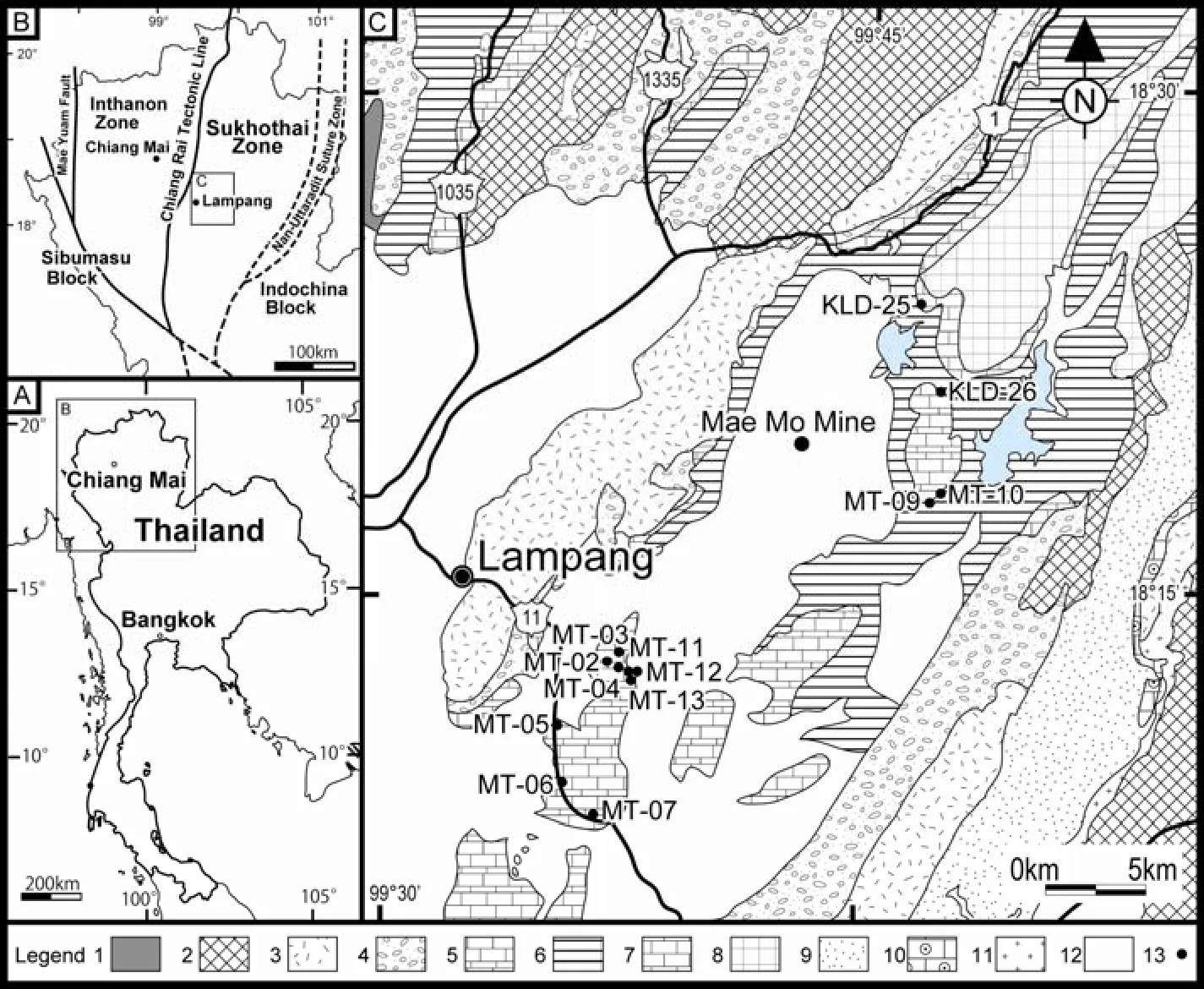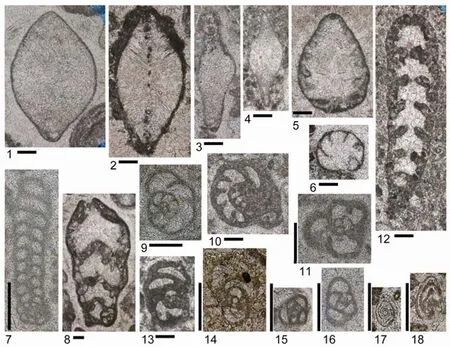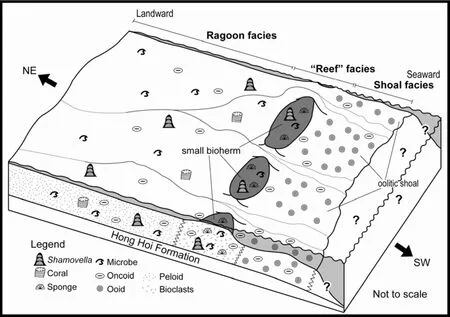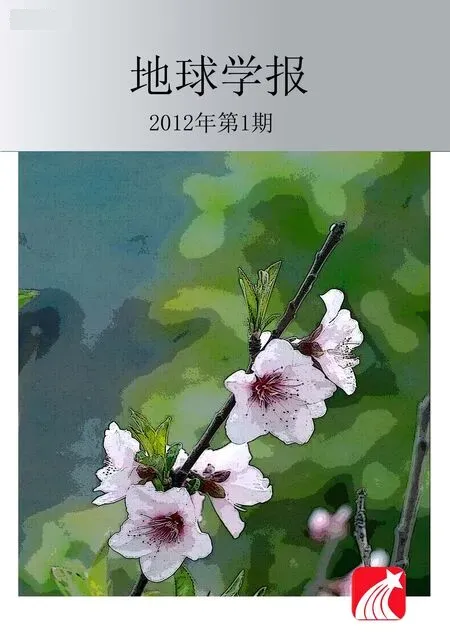泰国北部三叠系Lampang群doi Long组的有孔虫组合与沉积环境
泰国北部三叠系Lampang群doiLong组的有孔虫组合与沉积环境
* Corresponding author. E-mail: sd113501@cis.fukuoka-u.ac.jp.
0 Introduction
In Northern Thailand, recent geotectonic studies clarified that three geotectonic units can be recognized; from east to west, the Indochina Block, Sukhothai Zone, and Sibumasu Block (e.g. Ueno and Charoentitirat, 2011; Fig. 1B). Of them, the Sukhothai Zone has been thought to show an island arc system, which developed along the margin of the Indochina Block during Permian–Triassic time (Barr and Macdonald, 1991; Ueno, 1999). This zone is delineated by the Nan– Uttaradit Suture zone to the east and by the Chiang Rai Tectonic Line to the west. It is characterized by folded and thrust Paleozoic and Mesozoic sedimentary and volcanic rocks, intruded by scattered I-type granitoid plutons of Triassic age(Barr and Macdonald, 1991). Among them, Permian–Triassic sedimentary rocks were considered to be deposited on the fore-arc area of the Sukhothai arc(Chonglakmani, 1999).
Triassic strata in the Lampang–Phrae Basin of the Sukhothai Zone have been conventionally referred to as the Lampang Group. Recently, Chonglakmani (2011)proposed the Song Group for the Triassic in the Phrae Sub-basin to the east and restricted the use of the Lampang Group to those exposed in the Lampang Sub-basin to the west. In the latter sub-basin, the Lampang Group is subdivided into four formations. Of them, the Pha Kang anddoiLong formations consist mainly of carbonate rocks (Feng et al., 2005). The depositional age of the Lampang Group was thought to be from the Early Triassic to the Carnian (Late Triassic)based on ammonoids and bivalves (Chonglakmani and Grant-Mackie, 1993; Chonglakmani, 2011).
In spite of these studies on the age and stratigraphic outline of the group, its concrete lithostratigraphic and detailed chronostratigraphic frameworks have not been clarified yet. Moreover, there are only few reports on the foraminiferal faunas and depositional environment of the carbonate formations of this group until now (Kobayashi et al., 2006; Chaodumrong and Rao, 1992). In this study, we examine the foraminiferal age and depositional environment of thedoiLong Formation of the Lampang Group.
1 Geological setting
In the Lampang area of Northern Thailand,basement rocks include Paleozoic low-grade metamorphic rocks, Permian Ngao Group, Permian– Triassic volcanic rocks, Triassic Lampang Group, and Triassic granitoids (Fig. 1C). Among them, the Triassic Lampang Group is composed mainly of marine strata with minor fluvial deposits (Chonglakmani, 2011) and is widely distributed in this area. This group is subdivided into the Phra That, Pha Kang, Hong Hoi, anddoiLong formations in ascending order.
ThedoiLong Formation crops out in the northeast of Lampang (Fig. 1C) and its thickness is about 230 meters (Feng et al., 2005). This formation consists mainly of gray massive limestone with minor dark-gray to gray bedded limestone and has a general NE–SW strike. A Late Triassic (early Carnian) age was proposed for thedoiLong Formation based on ammonoids (Chonglakmani and Grant-Mackie, 1993). In the northern part of the area, this formation, together with the underlying Hong Hoi Formation and the overlying Pha Daeng Formation of the Song Group,forms a synclinal structure. Chaodumrong and Rao(1992) concluded thatdoiLong Formation was deposited in a ramp setting mainly because of the absence of reefal sediments in this formation.
Some of carbonate strata distributed in the east of the Mae Mo Mine and along the highway No. 11 of the study area were previously mapped as the Pha Kang Formation (e.g. Department of Mineral Resources,1999; Vimuktanandana, 2006). They are, however,more reasonable to be attributed to thedoiLong Formation (Fig. 1C) based on their foraminiferal age as well as their stratigraphic position.
2 Foraminiferal assemblage
In this study, we collected samples from 13 localities of thedoiLong Formation in the Lampang area (Fig. 1C) and found 29 taxa of foraminifers from them. They are dominated byAulotortus sinuosusandA. tumidus, and also containLamelliconus multispirus,Endotebaex gr.controversa,E.ex gr.badouxi,Endotebanella kocaeliensis,Endotriada tyrrhenica,Endotriadella wirzi,Malayspirina fontainei,Ammobaculites rhaeticus,Alpinophragmium perforatum,Diplotremina astrofimbriata,Agathammina austroalpina,Arenovidalina chialingchiangensis,Ophthalmidium tori,Gaudryina triadica,Nodosaria,Tetrataxis,Lenticulina, and others (Fig. 2).
Among these foraminifers, Aulotortidae is known as an indicator of the Late Triassic (e.g. Salaj et al.,1983).Ammobaculites rhaeticusis characteristic in the Late Triassic (Chablais et al., 2011).Malayspirina fontaineiwas also reported to occur in the Late Triassic (Fontaine et al., 1988; Zaninetti et al., 1992; Ueno et al., in press). On the other hand, well-known Norian-Rhaetian indicators such asTriasina hantkeni,Aulotortus friedli, andGandinella falsofriedliwere not found in thedoiLong assemblage. These lines of evidence suggest that the depositional age of this formation is most probably referable to the Carnian (early Late Triassic). This age assessment is consistent with that by ammonoids (Chonglakmani and Grant-Mackie,1992).
In the study area, Kobayashi et al. (2006) reported earlier Triassic foraminifers. Our localities MT-5 and MT-6 correspond to the localities 3 and 4 of Kobayashi et al. (2006), respectively. From their locality 4 (our MT-6), Carnian foraminifers were discriminated. On the other hand, the foraminiferal assemblage of Kobayashi et al.’s (2006) locality 3 was assigned by them to the Ladinian mainly because of the occurrence of the Ladinian-indicatingDiplotremina astrofimbriataand the lack of Carnian forms such as Aulotortidae. However,Aulotortuswas recovered from our MT-5, which confirmed a Carnian age for this sample.
3 Depositional environment of the doi Long Formation
In thedoiLong Formation, there are variable types of microfacies observed among the samples from the studied 13 localities. Based on the combination of characteristic microfacies, we subdivide the study area into three (northern, central, and southern) in view of reconstruction of depositional environment of this formation.
In the northern area (KLD-25, 26, MT-9, 10; Fig.1C), peloidal grainstone including oncoid andShamovella(formerlyTubiphytes: Riding, 1993) is dominant. This peloidal grainstone includes binding textures formed byShamovella, microbes, and minor skeletal organisms, the latter of which has generally recrystallized completely in thin section. They formed small-scale boundstone in peloidal grainstone. Bioclasts are not very diagnostic in limestones of this area;their amount gradually increases southward. Oncoids found here are of weakly laminated meshwork type and exhibit random growth representing less frequent rolling during formation (Flügel, 2004). Most ofShamovellaare small and only few centimeters in size.Among non-skeletal grains, peloids are generally common in a protected shallow-marine environment(Flügel, 2004). That type of oncoids found in the northern area is known to occur in a low wave-energy environment (Flügel, 2004).Shamovellafound in this area contributed only to form small-scale boundstones.Therefore, a shallow lagoon environment is assumed for thedoiLong Formation distributed in this part(Fig. 3), because of the dominant peloid and the presence of oncoid and small-scaleShamovella(Wright and Burchette, 1996).

Fig. 1 Geotectonic units of Northern Thailand and geologic map of the Lampang area A-Index map of Thailand; B-Geotectonic map of Northern Thailand (modified from Ueno and Charoentitirat, 2011); C-Geologic map of the Lampang area (modified from Department of Mineral Resources, 1999); 1-basement rocks; 2-Permian Ngao Group; 3-Permian–Triassic volcanic rocks; 4–7-Lampang Group(4-Phra That Formation; 5- Pha Kang Formation; 6-Hong Hoi Formation; 7-doi Long Formation);8–10-Song Group(8-Pha Daeng Formation; 9-Kang Phra Formation; 10-Wang Chin Formation); 11-Triassic granitoid; 12-Cenozoic;13-Sample locality

Fig. 2 Photomicrographs of Carnian foraminifers from the doi Long Formation. Scale bar is 0.2mm. 1, 2. Aulotortus sinuosus Weynschenk, 1: from MT-13, 2: from MT-3. 3, 4. Aulotortus tumidus Kristan-Tollmann, both from MT-11. 5.Lamelliconus multispirus Oberhauser, from MT-11. 6. Dplotremina astrofimbriata Kristan-Tollmann, from MT-6. 7. Endotriadella wirzi Koehn-Zaninetti, from MT-10. 8. Ammobaculites rhaeticus Kristan-Tollmann, from MT-13. 9. Endotriada tyrrhenica Vachard, Martini, Rettori and Zaninetti, from MT-9. 10. Endoteba ex gr. badouxi (Zaninetti and Brönniman), from MT-9. 11,14. E. ex gr. controversa Vachard and Razgallah, 11: from MT-12, 14: from MT-7. 12. Malayspirina fontainei Vachard, from MT-4. 13. Endotebanella kocaeliensis (Dager), from MT-9. 15, 16. Agathammina austroalpina Kristan-Tollmann and Tollmann,both from MT-12. 17, 18. Ophthalmidium tori Zaninetti and Brönnimann, both from MT-7

Fig. 3 Schematic depositional model of the doi Long Formation
In the central area (MT-2, 3, 4, 5, 6, 11, 12, and 13; Fig. 1C), bioclastic grainstone having large voids that are partly filled with radiaxial-fibrous calcite cement is characteristic and sponge-microbe boundstone,oncoidal grainstone, and others are also found. The boundstone is composed of sclerosponges, sphinctozoan sponges, and microbes in association with minor microproblematica such asShamovella,Bacinella, andMicrotubus. Judging from the dimension of the boundstone, these reef builders probably constructed patch reefs or small-sized bioherms in the grainstone.The bioclastic grainstone with radiaxial-fibrous calcite cement is well known in reef and fore reef settings(Flügel, 2004). Thus, thedoiLong Formation in this area probably exhibits a small-scale reef environment(Fig. 3) although the development of reefal sediment seems to be relatively small.
Oolitic grainstone is abundantly found in the southern area (MT-7; Fig. 1C). Bioclasts are less conspicuous in limestones of this area. Low-angle cross-stratification, which is similar to hummocky cross-stratification, is recognized in some beds. In some horizons, oncoidal grainstone and sandy limestone yielding abundant quartz grains occur. Bioclastic grainstone, which contains fragments of sponges and reworking grains such as debris of reef builders, were also recognized in some horizons. This bioclastic grainstone resembles that found in the reef facies in its grain components. Oolitic grainstone is generally common in shoal facies sediments (Flügel,2004).Thus, a shoal environment is considered for this area of thedoiLong Formation (Fig. 3). Intervening oncoidal grainstone, bioclastic grainstone, and reworking grains in oolitic grainstone would suggest that the reef facies and shoal facies in thedoiLong Formation were adjacent each other (Fig. 3). Moreover,the sandy limestone with abundant quartz grains suggests that clastic deposition occurred relatively close to this area.
In conclusion, three depositional environments,represented by the lagoon, reef, and shoal facies, can be recognized in thedoiLong Formation of the study area (Fig. 3). Thus, this formation is deposited presumably in a reef or bank setting rather than a ramp setting.
BARR S M, MACDONALD A S. 1991. Toward a late Paleozoic-early Mesozoic tectonic model for Thailand. Journal of Thai Geosciences, 1: 11-22.
CHABLAIS J, MARTINI R, KOBAYASHI F, STAMPFLI G M,ONOUE T. 2011. Upper Triassic foraminifers from Panthalassan carbonate buildups of Southwestern Japan and their paleobiogeographic implications. Micropaleontology, 57:93-124.
CHAODUMRONG P, RAO P. 1992. Depositional environments of Triassic carbonates, Lampang Group, Central North Thailand.In: Piancharoen, C. (ed.): Proceedings of a National Conference on Geologic Resources of Thailand: Potential for Future Development. Department of Mineral Resources, Bangkok,355-367.
CHONGLAKMANI C. 1999. The Triassic system of Thailand:Implications for the paleography of Southeast Asia. In:Ratanasthien, B., & Rieb, S. L. (eds.): Proceedings of the International Symposium on Shallow Tethys (ST) 5, Department of Geological Sciences, Faculty of Science, Chiang Mai University, Chiang Mai, 486-495.
CHONGLAKMANI C. 2011. Chapter 6 Triassic. In: Ridd, M. F.,Barber, A. J., & Crow, M. J. (eds.): The Geology of Thailand,The Geological Society, London, 137-150.
CHONGLAKMANI C, GRANT-MACKIE J A. 1993. Biostratigraphy and facies variation of the marine Triassic sequences in Thailand. In: Thanasuthipitak, T. (ed.): International symposium on Biostratigraphy of Mainland Southeast Asia: Facies and Paleontology (BIOSEA), Chiang Mai, 1: 97-123.
Department of Mineral Resources. 1999. Geological map of Thailand, Scale 1:1,000,000, Geological Survey Division, Department of Mineral Resources , Bangkok.
FENG Q L, CHONGLAKMANI C, HELMCKE D,INGAVAT-HELMCKE R, LIU B. 2005. Correlation of Triassic stratigraphy between the Simao and Lampang-Phrae Basins:implications for the tectonopaleogeography of Southeast Asia.Journal of Asian Earth Sciences, 24: 777-785.
FLÜGEL E. 2004. Microfacies of Carbonate Rocks. Springer, Berlin, Heidelberg, New York, 976.
FONTAINE H, KHOO H P, VACHARD D. 1988. Discovery of Triassic fossils at Bukit Chuping, in Gunung Sinyum area, and at Kota Jin, Peninsular Malaysia. Journal of Southeast Asian Earth Sciences, 2: 145-162.
KOBAYASHI F, MARTINI R, RETTORI R, ZANINETTI L,RATANASTIEN B, SAEGUSA H, NAKAYA H. 2006. Triassic foraminifers of the Lampang Group (Northern Thailand).Journal of Asian Earth Sciences, 27: 312-325.
RIDING R. 1993.Shamovella obscura: the correct name forTubiphytes obscurus(Fossil). Taxon, 42: 71-73.
SALAJ J, BORZA K, SAMUEL O. 1983. Triassic foraminifers of the West Carpathians. Geologický ústav Dionýza Štúra, Bratislava: 213.
UENO K. 1999. Gondwana/Tethys divide in East Asia: Solution from Late Paleozoic foraminiferal paleobiogeography. In :Ratanasthien, B., & Rieb, S. L. (eds.): Proceedings of the International Symposium on Shallow Tethys (ST) 5, Department of Geological Sciences, Chiang Mai University, Chiang Mai,45-54.
UENO K, CHAROENTITIRAT T. 2011. Chapter 5 Carboniferous and Permian. In: Ridd, M. F., Barber, A. J., & Crow, M. J.(eds.): The Geology of Thailand, The Geological Society,London, 71-137.
UENO K, MIYAHIGASHI A, KAMATA Y, KATO M,CHAROENTITIRAT T, LIMRUK S. 2012. Geotectonic implications of Permian and Triassic carbonate successions in the Central Plain of Thailand. Journal of Asian Earth Sciences,doi:10.1016/j.jseaes.2012.04.015(in press).
VIMUKTANANDANA S. 2006. Geological map of Changwat Lampang, Scale 1:250,000. Department of Mineral Resources,Bangkok.
WRIGHT V P, BURCHETTE T P. 1996. Shallow-water carbonate environments. In: Reading, H. G. (ed.): Sedimentary Environments: Processes, Facies, and Stratigraphy, Blackwell Science,Oxford, 325-394.
ZANINETTI L, MARTINI R, DUMONT T. 1992. Triassic foraminifers from sites 761 and 764, Wombat Plateau, Northwestern Australia. In: Rad, U., Haq, B. U. et al. (eds.): Proceedings of the Ocean Drilling Program, Scientific Results,Volume 122. The Ocean Drilling Program, Texas & M University, College Station, 427-436.
Foraminiferal Assemblage and Depositional Environment of thedoiLong Formation (Triassic Lampang Group), Northern Thailand
Akira MIYAHIGASHI1)*, Katsumi UENO2), Thasinee CHAROENTITIRAT3),Yoshihito KAMATA4)
1)Doctoral program in Earth System Science, Graduate School of Science, Fukuoka University, Fukuoka814-0180,Japan;
2)Department of Earth System Science, Faculty of Science, Fukuoka University, Fukuoka814-0180,Japan;
3)Department of Geology, Faculty of Science, Chulalongkorn University, Bangkok10330,Thailand;
4)Graduate School of Life and Environmental Science, University of Tsukuba, Tsukuba305-8572,Japan
A rich foraminiferal assemblage, consisting of abundantAulotortus sinuosusandA. tumidusin association withLamelliconus multispirus,Endotebaex gr.controversa,E.ex gr.badouxi,Endotebanella kocaeliensis,Endotriada tyrrhenica,Endotriadella wirzi,Malayspirina fontainei,Ammobaculites rhaeticus,Diplotremina astrofimbriata,Agathammina austroalpina, and others, was found in thedoiLong Formation of the Triassic Lampang Group, Northern Thailand. These foraminifers suggest that the formation is referable to the Carnian (early Late Triassic), which is consistent with the age estimated by ammonoids. In microfacies, peloidal grainstone, bioclastic grainstone, sponge-microbial boundstone, and oolitic grainstone were recognized in thedoiLong Formation. Based on microfacies, three depositional facies, the lagoon facies, reef facies, and shoal facies,are recognized in this formation. These lines of evidence are suggestive that thedoiLong Formation was deposited in a reef or bank setting rather than a ramp setting.
Carnian;doiLong Formation; Lampang Group; foraminifers; Sukhothai Zone; Northern Thailand
10.3975/cagsb.2012.s1.24

